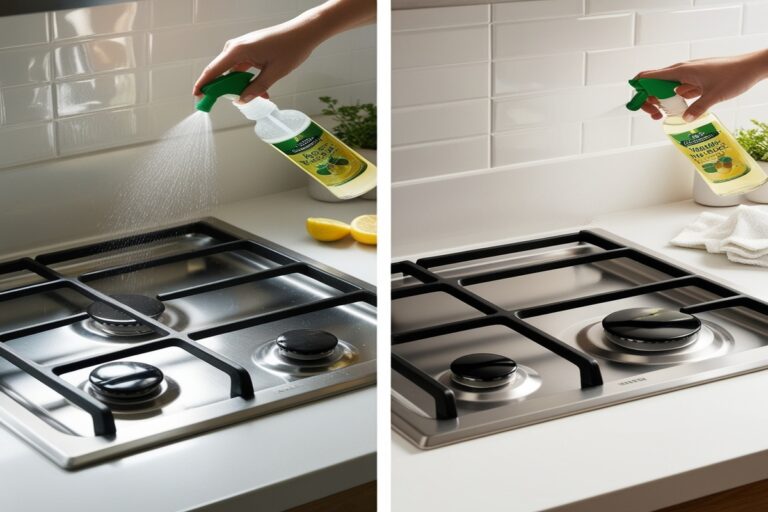Cleaning the kitchen is an essential task for maintaining a healthy and pleasant home environment. Among the various kitchen appliances, the stove often requires special attention due to the accumulation of grease and food residues. While there are many commercial cleaning products available, they often contain harsh chemicals that can be harmful to both health and the environment. This is where vinegar comes in as a natural, effective, and economical cleaning solution. In this guide, we will explore how to clean your stove using vinegar, providing you with a simple and sustainable method to keep your kitchen sparkling clean.
1. Why Choose Vinegar for Cleaning?
Vinegar has long been recognized for its versatility in household cleaning. Its acidic nature makes it a powerful agent against grease and stains, breaking down tough residues without the need for abrasive chemicals. Here are some reasons why vinegar is an excellent choice for cleaning your stove:
- Natural and Economical: Vinegar is a natural product that is both affordable and widely available. Unlike many commercial cleaners, it does not contain synthetic chemicals, making it a safer option for your home and the environment.
- Effective Against Grease: The acetic acid in vinegar effectively cuts through grease, making it ideal for cleaning kitchen surfaces, including stoves.
- Safe for All Surfaces: Vinegar can be used on a variety of surfaces, including stainless steel, glass, and enamel, without causing damage.
- Easy to Find: Available in most grocery stores, vinegar is a convenient option for those looking to simplify their cleaning routine.
- Free of Harsh Chemicals: Using vinegar reduces your exposure to potentially harmful chemicals found in many traditional cleaning products.
For more information on the benefits of vinegar in cleaning, you can read more on Healthline.
2. Necessary Materials
Before you begin cleaning your stove with vinegar, gather the following materials to ensure a smooth and efficient process:
- 1 cup of white vinegar
- 1 cup of filtered water
- 1 clean spray bottle
- 1 soft cloth
- 1 new sponge
- Dry cloth for finishing
These materials are easy to find and will help you achieve the best results in your cleaning efforts.
3. Preparing the Cleaning Mixture
Creating a vinegar-based cleaning solution is simple and quick. Follow these steps to prepare your mixture:
- Mix Equal Parts: Combine one cup of white vinegar with one cup of filtered water in a clean spray bottle. This dilution helps to balance the acidity of the vinegar while maintaining its cleaning power.
- Shake Well: Before using, shake the spray bottle well to ensure the vinegar and water are thoroughly mixed.
- Optional Enhancements: For added cleaning power and a pleasant scent, consider adding a few drops of essential oils such as lemon or lavender. These oils not only enhance the cleaning properties but also leave a refreshing aroma.
For more natural cleaning solution recipes, check out Good Housekeeping.
4. Step-by-Step Stove Cleaning
Now that your cleaning solution is ready, follow these detailed steps to clean your stove effectively:
- Prepare the Stove: Ensure the stove is cool before starting. Remove all grates and burner covers to access the entire surface.
- Apply the Solution: Generously spray the vinegar solution over the stove surface, focusing on areas with visible grease and stains. Allow the solution to sit for about 5 minutes to break down the grime.
- Wipe Clean: Use a soft cloth to wipe away the solution, applying gentle pressure to remove stubborn spots. For tougher stains, a new sponge can be used to scrub gently.
- Rinse and Dry: After cleaning, use a damp cloth to rinse the surface, removing any remaining vinegar residue. Finish by drying the stove with a clean, dry cloth to prevent water spots.
- Tackle Tough Stains: For particularly stubborn grease, apply undiluted vinegar directly to the area and let it sit for 10 minutes before wiping clean. Repeat the process if necessary.
5. Tips and Tricks for Effective Cleaning
To optimize your stove cleaning routine, consider these helpful tips:
- Clean When Cool: Always ensure the stove is cool to the touch before cleaning to avoid burns and ensure the cleaning solution works effectively.
- Avoid Abrasive Sponges: Use soft cloths or sponges to prevent scratching the stove’s surface.
- Dry Thoroughly: After cleaning, dry the stove completely to prevent water spots and maintain a shiny finish.
- Maintain Regular Cleaning: Incorporate stove cleaning into your regular kitchen routine to prevent the buildup of grease and grime.
6. Daily Stove Maintenance
Regular maintenance is key to keeping your stove in top condition. Here are some daily practices to adopt:
- Clean Spills Immediately: Wipe up spills as soon as they occur to prevent them from hardening and becoming difficult to remove.
- Wipe with a Damp Cloth: Use a damp cloth to wipe down the stove daily, removing any light grease or food particles.
- Avoid Grease Buildup: Regular cleaning prevents the accumulation of grease, making deep cleaning sessions less frequent and easier.
- Keep the Mixture Ready: Store your vinegar cleaning solution in a convenient location for quick access whenever needed.
7. Precautions When Using Vinegar
While vinegar is a safe and natural cleaning agent, it’s important to follow these precautions:
- Wait for the Stove to Cool: Always ensure the stove is cool before applying the cleaning solution.
- Test on a Small Area: Before using vinegar on a new surface, test it on a small, inconspicuous area to ensure it does not cause discoloration or damage.
- Avoid Mixing with Other Products: Do not mix vinegar with bleach or other cleaning products, as this can create harmful fumes.
- Keep the Area Ventilated: Ensure good ventilation when cleaning to disperse any vinegar odor quickly.
For more on cleaning product safety, visit Mayo Clinic.
8. Frequently Asked Questions
Q: Is vinegar safe for any stove?
A: Yes, vinegar can be used on stainless steel, glass, and enameled stoves.
Q: How often should I clean?
A: Ideally, clean after each use to maintain a spotless stove.
Q: Does the vinegar smell linger?
A: No, the odor dissipates quickly after drying.
Conclusion: Cleaning the Stove with Vinegar
In conclusion, using vinegar for stove cleaning is a practical, economical, and efficient solution. This simple method allows you to keep your stove clean and shiny while minimizing your environmental impact. By incorporating vinegar into your cleaning routine, you can enjoy a healthier home and a more sustainable lifestyle. Start using this technique today and discover how it can simplify your cleaning routine!
For more tips on household cleaning, you can visit Good Housekeeping for additional guidance and cleaning tricks.
You might also like:
- Tourist Spots in the Interior of São Paulo: Wonders of the Paulista Countryside
- Emergency Fund in 6 Months: Security Within Your Reach
- The Ideal Credit Card for You: A Complete Guide
- Basic Mashed Potatoes: Simplicity and Flavor in Every Spoonful
- Chef John’s Creamy Corn Pudding: An Irresistible Delight


